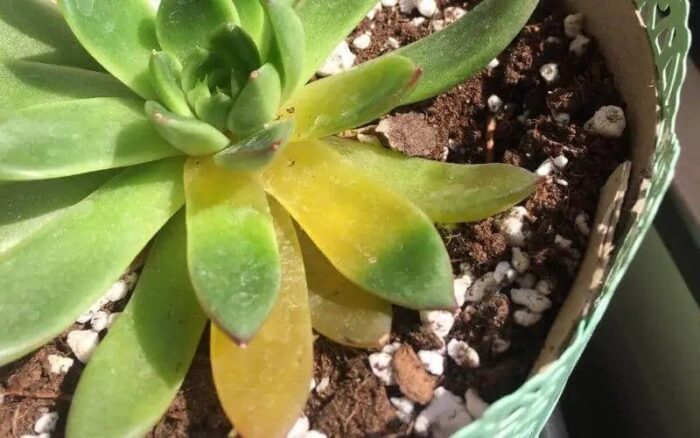The elegant-looking echeveria plant, sometimes referred to as the hen and chicks plant, is a stunning and low-maintenance succulent that enhances any garden. The yellowing of foliage is a regular problem for echeveria owners, though. Several things, such as excessive watering or a lack of sunshine, might contribute to this. This blog article will discuss the causes of echeveria leaves becoming yellow as well as solutions to the problem.

The Echeveria Is Not Getting Enough Water
A lack of moisture is a frequent reason for yellowing leaves. When your Echeveria is not receiving enough water, its leaves will begin to droop in an effort to reduce water loss through transpiration. This is a way for the plant to conserve water. As the leaves prepare to fall off, they will turn yellow.
To determine if your plant is dry, you can check the soil by sticking your finger into it. If it is dry, it is important to establish a consistent watering schedule. Additional indicators that your plant is not receiving enough water include curled drooping, or brittle-appearing leaves. You should water your Echeveria every one to two months.
The Dangers of Overwatering Your Echeveria
When it comes to Echeveria, overwatering is a typical problem that can result in yellowing of the leaves. This is because too much moisture can cause the roots to rot, which prevents them from properly absorbing nutrients. Remember that Echeveria is a succulent and needs well-draining soil and rarely watering.
Always inspect the soil before watering, and make sure it is totally dry before providing extra water, to prevent overwatering. To guarantee that extra water can drain, it’s also a good idea to choose a pot with drainage holes. Trust me, a little amount of care and attention to detail can go a long way toward keeping your Echeveria healthy and bright.
Nutrient Deficiency in the Echeveria
Deficiencies of nitrogen, potassium, magnesium, and iron could be responsible for the yellow leaves on your Echeveria plant. The most notable culprits as far as deficiency goes are nitrogen, potassium, magnesium, and iron. Deficits manifest themselves as chlorosis, yellowing of the leaves around their veins. This gives them a distinct appearance, making them easier to diagnose.
The soil will need better-balanced fertilizer or some good, old-fashioned fertilizer to address nutrient deficiencies. A nutrient may be inhibited from being absorbed if there is too much of it. It is important to keep everything in balance.
How Lack of Light Can Harm Your Echeveria
Plants will not produce enough chlorophyll if they do not receive enough light. Echeverias will suffer from yellowing leaves and poor health as a result. The light should be adequate for your plants, but not too much or too direct, depending on the type of plant.
The Echeveria plant needs a minimum of six hours of sunlight per day. Plants lose their attractive, compact form when they do not receive extended, direct light.
Your Echeveria Is Getting Too Much Light
Despite the fact that your Echeveria plant needs light to survive, there is such a thing as too much light. Sunlight that is too bright or excessive will not benefit your plants but instead, cause them to overheat and get sunburned.
Unless they love direct sunlight, don’t place plants directly in the sun. In terms of houseplants, make sure that they are at least a few feet away from windows and that they have enough light. The leaves should be given a break from being overheated and yellowing.
Consequences of Improper Soil pH for Your Echeveria
It is the pH of the soil that determines the preference of any plant, and it ranges anywhere between 1-14, usually somewhere in the middle. The soil’s acidity or alkalinity can cause discomfort if it is too alkaline at 14. It is possible that the roots of the plant might even have difficulty absorbing the necessary nutrients from the soil. The yellowing of a plant’s leaves can be attributed to this factor.
The soil pH for Echeveria plants should be slightly acidic to slightly alkaline, between 6.1 and 7.5. Echeveria plants prefer well-draining, sandy soil that has been amended with organic matter. You can test the pH of your soil with a pH tester you can purchase online or at a store. Yellow leaves are unlikely to appear if pH is within the correct range. You might just be able to balance it out properly if it’s too acidic or too alkaline.
Dealing With Pests and Disease On Your Echeveria
Pests are usually responsible for yellowing leaves on your Echeveria, so you can easily spot them. It is common for yellow spots to appear around bite marks and bullet marks on plant leaves. It is possible to see yellowing foliage, as well as the pest itself if you look closely. In general, aphids, whiteflies, scaly bugs, spider mites, and thrips are the most common pests.
There are numerous species of winged bugs, as well as those that look like scales, fluff, or tiny winged insects. A simple pesticide will usually solve most pest problems. Neem oil is a natural pesticide that can replace chemical pesticides.
It may also be possible to remove the stain with simple dish soap and water. There are quite a few pests around, and they are normally easy to get rid of.
Is It Possible for Yellowing leaves To Turn Green Again?
While it’s unlikely that yellow leaves will revert back to their vibrant green color, there’s still hope for your Echeveria.
By identifying the cause of the yellowing and taking action to address it, you can prevent the spread of other leaves. And with a quick pruning of the yellowed leaves, your Echeveria plant will have the opportunity for a fresh start and new growth.
Don’t let a few yellow leaves signify the end for your plants, take action and enjoy lush greenery once again.
Frequently Asked Questions About The Echeveria
What is an Echeveria plant?
An Echeveria plant is a type of succulent plant that is native to Central and South America. It is known for its colorful foliage and low maintenance requirements.
How do I care for an Echeveria plant?
Echeveria plants require well-draining soil, plenty of sunshine, and occasional watering. Be sure to avoid overwatering and ensure the soil has proper drainage.
What type of light does an Echeveria plant need?
An Echeveria plant needs bright light to thrive, so it should be placed in a spot with plenty of light, such as a sunny window.
How often should I water an Echeveria plant?
An Echeveria plant should be watered once a week, or when the top inch of soil is dry.

About Author
Hannah Anderson is a passionate garden enthusiast with over a decade of experience. She has been sharing her knowledge and expertise on this website and her articles and tips have helped countless individuals create beautiful and thriving gardens. Whether you’re a seasoned green thumb or just starting out, Hannah’s practical advice and creative ideas will inspire and guide you on your gardening journey.
